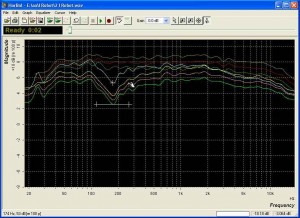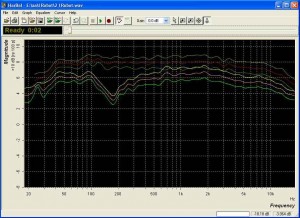Last Updated on December 22, 2015 by
Harmonic Balancing has nothing to do with Feng Shui but everything to do with creating balanced frequencies in a recording. We perform an EQ balancing act…
Information

Product: HarBal
Manufacturer: Har-Bal
Price: $175
Web: Har-Bal
Two of the most difficult aspects of mixing and mastering are to get a good harmonic balance for individual tracks, and to balance tracks in an album as a whole. Typically, you adjust the harmonic content of each track during mixing and hope they all fit together, tweaking here and there if they don’t.
HarBal’s Gain Change cursor is used to adjust the frequency curve to even out the peaks and troughs. (click to enlarge)HarBal was designed to make this process easier. Open an audio file and the program analyses its frequency content. It produces a graphic display consisting of three lines – the average energy content of the file at different frequencies, the peak energy content, and the mean of the two.
Immediately you can see if there are any harmonic troughs or peaks. Using the Gain Change cursor you simply click and drag on the spectrum to change the shape of the curve. In other words you can visually balance the entire audio frequency of a track. You can playback the original and the new versions and click a button to do an A/B comparison. It’s easy, but it’s worth remembering that while adjustments can be done purely on a visual basis, it will help if you if you know where sounds and instruments sit in the mix.
Good references
Balancing MP3 files
HarBal doesn’t currently support MP3 files although there are plans to add it. However, MP3 is a lossy format and encoding removes frequency content that cannot be recovered so harmonic balancing will not be optimal. To balance MP3 files, first balance the full audio file and then convert it to MP3 format.
Being able to change a track’s spectrum in this way is neat enough but there’s more. After creating the perfect settings for a track, you can save the new filter as a reference file which can be displayed while processing other tracks so you can use it as guide.
The program comes with several reference files for common music genres including rock, contemporary, rhythm and blues, hip hop, jazz, jazz fusion, folk, techno and classical. These are excellent starting points and if you have a song with a poor balance you’ll soon be able to whip it into shape with these.
Copy cat


Compensation society
Okay, so perhaps you could do something similar with a multi-band filter but it won’t be so easy and it almost surely won’t be as cheap! And HarBal has another major plus up its sleeve – loudness compensation. This is incredibly important. If you’re mixing a track and boost the EQ, does the result sound better or worse? It sounds better because the boosted frequencies make it louder and our ears tell us this is better. This makes it difficult to tell whether or not the EQ change itself is an improvement.
The only way to do an accurate A/B comparison is to reduce the loudness by a commensurate amount when you boost the EQ – or increase the loudness if you cut EQ. HarBal takes the hard work – or impossibility! – out of doing this by automatically compensating for any increase in the loudness so you get an accurate impression of what the filter is doing. Brilliant!
You can download a demo from the site but playback is limited to 8-bit which sort of defeats the object of the exercise. However, there’s also an active forum where you can find answers to most questions you may have. HarBal could be improved in a few areas and doubtless many are being considered, and the developer is already working on Mac and plug-in versions. Meanwhile, it’s an ingenious program, well worth a close look by anyone who wants to improve their tracks.
Pros
Visual spectrum displays
Quick spectrum balancing
Helps balance tracks in an album
Automatic loudness compensation
Mono file support
Cons
No MP3 support yet
No Mac version yet
Summary
HarBal is a unique program, extremely affordable and probably the quickest and easiest way to balance audio material.
8/10
Minimum system requirements
PC: Pentium with sound card running Windows 95/98SE/Me/2000/XP
Features
Supports 16-, 24- and 32-bit audio at 96kHz
Mono and stereo file support
Real-time track preview
Loudness compensation















